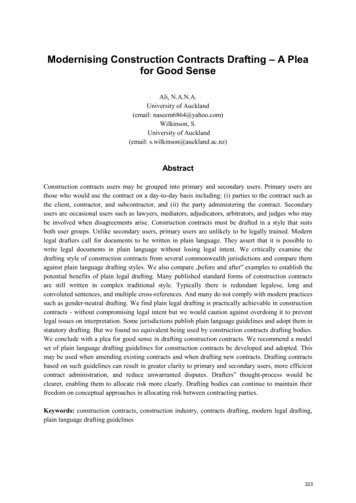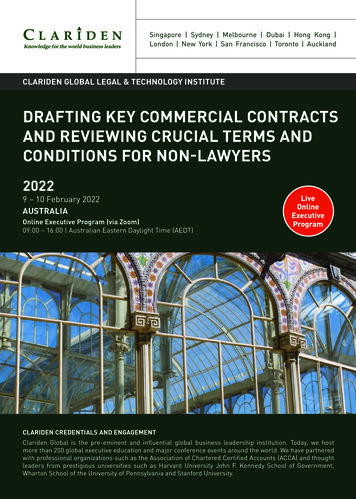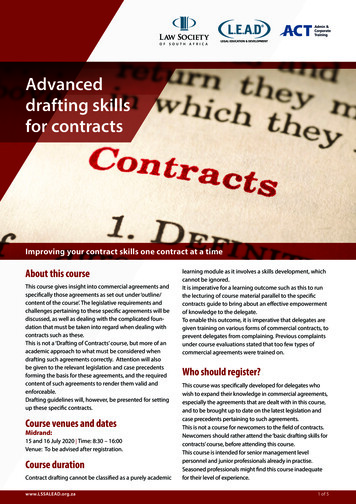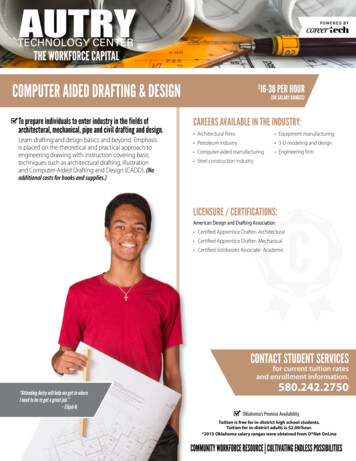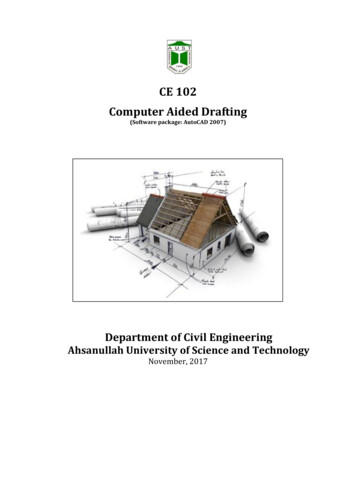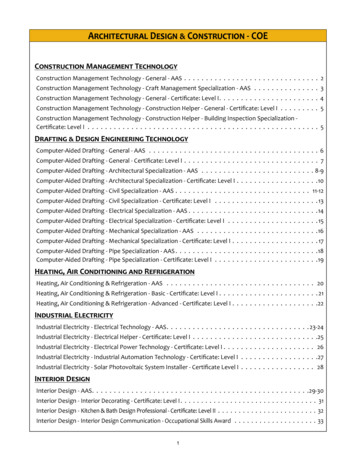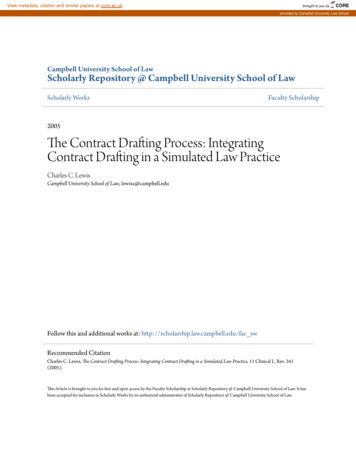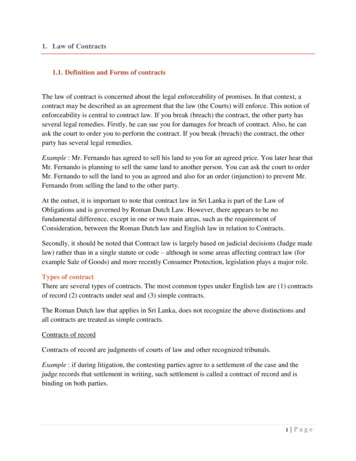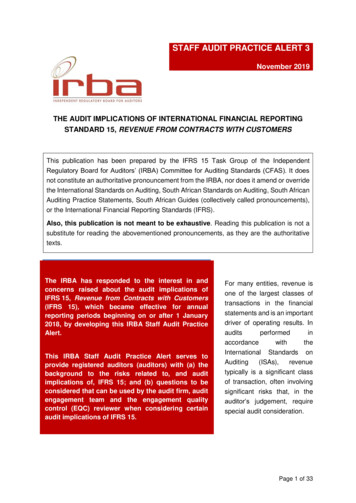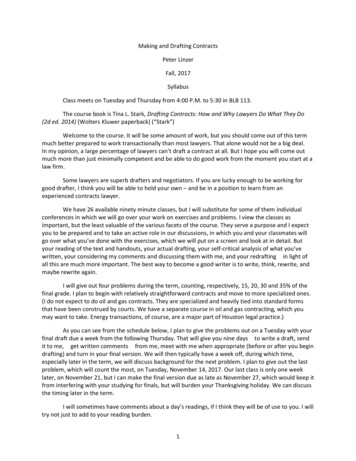
Transcription
Making and Drafting ContractsPeter LinzerFall, 2017SyllabusClass meets on Tuesday and Thursday from 4:00 P.M. to 5:30 in BLB 113.The course book is Tina L. Stark, Drafting Contracts: How and Why Lawyers Do What They Do(2d ed. 2014) (Wolters Kluwer paperback) (“Stark”)Welcome to the course. It will be some amount of work, but you should come out of this termmuch better prepared to work transactionally than most lawyers. That alone would not be a big deal.In my opinion, a large percentage of lawyers can’t draft a contract at all. But I hope you will come outmuch more than just minimally competent and be able to do good work from the moment you start at alaw firm.Some lawyers are superb drafters and negotiators. If you are lucky enough to be working forgood drafter, I think you will be able to hold your own – and be in a position to learn from anexperienced contracts lawyer.We have 26 available ninety minute classes, but I will substitute for some of them individualconferences in which we will go over your work on exercises and problems. I view the classes asimportant, but the least valuable of the various facets of the course. They serve a purpose and I expectyou to be prepared and to take an active role in our discussions, in which you and your classmates willgo over what you’ve done with the exercises, which we will put on a screen and look at in detail. Butyour reading of the text and handouts, your actual drafting, your self-critical analysis of what you’vewritten, your considering my comments and discussing them with me, and your redrafting in light ofall this are much more important. The best way to become a good writer is to write, think, rewrite, andmaybe rewrite again.I will give out four problems during the term, counting, respectively, 15, 20, 30 and 35% of thefinal grade. I plan to begin with relatively straightforward contracts and move to more specialized ones.(I do not expect to do oil and gas contracts. They are specialized and heavily tied into standard formsthat have been construed by courts. We have a separate course in oil and gas contracting, which youmay want to take. Energy transactions, of course, are a major part of Houston legal practice.)As you can see from the schedule below, I plan to give the problems out on a Tuesday with yourfinal draft due a week from the following Thursday. That will give you nine days to write a draft, sendit to me, get written comments from me, meet with me when appropriate (before or after you begindrafting) and turn in your final version. We will then typically have a week off, during which time,especially later in the term, we will discuss background for the next problem. I plan to give out the lastproblem, which will count the most, on Tuesday, November 14, 2017. Our last class is only one weeklater, on November 21, but I can make the final version due as late as November 27, which would keep itfrom interfering with your studying for finals, but will burden your Thanksgiving holiday. We can discussthe timing later in the term.I will sometimes have comments about a day’s readings, if I think they will be of use to you. I willtry not just to add to your reading burden.1
Counseling and Psychological Services (CAPS) can help students who are having difficulties managingstress, adjusting to the demands of a professional program, or feeling sad and hopeless. You can reach CAPS(www.uh.edu/caps) by calling 713-743-5454 during and after business hours for routine appointments or if you orsomeone you know is in crisis. No appointment is necessary for the “Let's Talk” program, a drop-in consultationservice at convenient locations and hours around campus. http://www.uh.edu/caps/outreach/lets talk.htmlHere is the syllabus, day by day:Tuesday, August 22, 2017: Handouts on good writing: George Orwell, Politics and the EnglishLanguage; the opening and closing of the Declaration of Independence; E.B. White’s unsigned oneparagraph Talk of the Town piece immediately after the Assassination of President Kennedy, The NewYorker from November, 1963. These will be on line as part of the First Day Assignments.None of these is about contract drafting, but good drafting must first of all be good writing.Orwell, the author of 1984 and Animal Farm, was himself a first-rate writer and was very concerned withthe way the choice of words can affect how we think about an issue. Obviously this is very relevant tocontract drafting. Much of his essay is about bad writing, often by prominent writers, but his basicpoint is that politicians often use vague terms or complicated and obfuscatory constructions to lead usoff the point . In the Appendix to 1984 he discusses Newspeak, which the totalitarian governmentrequired its subjects to use in place of traditional language. He says that in a relatively short time itwould have become impossible to say the portion of the Declaration of Independence that I am askingyou to read, except with the one word “crimethink.” (The great Justice John Marshall Harlan said muchthe same thing in Cohen v. California, 403 U.S. 15 (1971) (the “Fuck the Draft” case) – that if governmentcan control what words we are allowed to use, it can limit political speech. The words you use in draftinga contract are critical to its meaning and must be carefully chosen.The opening and closing of the Declaration of Independence are some of the best writing in allAmerican literature, and in the opinion of many, are the bedrock of our nation, even more than theConstitution. It is true that Thomas Jefferson, who wrote that “all men are created equal,” owned twohundred slaves. What the Declaration’s concepts and its words mean has changed over the centuries,and the opening words can be viewed as aspirational, as for instance, “all men” became ever moreinclusive, adding, among others, poor white men, black men, wo-men, and, until recently, at least,immigrants. The closing paragraph was anything but fluff; those who signed the Declaration knew that ifwe lost the war, they would be hanged as traitors. When they pledged “our lives, our fortunes and oursacred honor,” they meant that literally. In contract drafting, we usually want to be literal and precise,but a contract may inspire reliance, not on its exact words but on the relationship it appears to becreating. It’s generally better to be precise about the relationship rather than implicit, but bothapproaches may be present. We’ll discuss this throughout the course.Finally, read E.B. White’s paragraph on JFK. Kennedy was killed about 1:00 P.M., Eastern Time,on Friday, November 22, 1963. White, the great essayist (and author of Charlotte’s Web) was, I believe,living in Maine, and The New Yorker’s book closed early in the next week. In that pre-email, pre-fax day,White had to recover from the shock the whole nation felt, write his piece and get it by phone ortelegraph to The New Yorker over that weekend. It was tacked on to other pieces hastily rewritten and,as was The New Yorker’s style in those days, was unsigned. It is the best paragraph I’ve ever read. (Anote about White’s opening: in 1963 most men of a certain age wore hats. (When associates becamepartners, they bought themselves hats.) But JFK, who was 46 and the President of the United States,went bareheaded. It was symbolic of the generational youthfulness that he projected.)2
Read these three pieces, think about them, and come in ready to discuss the use of words,sentences, paragraphs, and unwritten but (mis)understood words(understood by one side, by bothsides, by all?).Thursday, August 24, 2017: Getting started. Stark 1-27. While I don’t agree with every word shewrites, I think that Professor Stark’s book is first-rate. She was a mergers and acquisitions partner in aWall Street law firm before teaching the practice of transactional lawyering, first at Fordham, then atEmory in Georgia and Boston University. The book shows her perspective as an M&A lawyer, which isfine, but not the only way. Where I disagree, I’ll say so, but I want to emphasize that she is almostalways right, that this is a book that you will learn a lot from, and that you’ll probably want to keep it asa reference as you begin the practice of law. Feel free to look at her prefaces, pp. xxv-xxviii, though youcan skip them if you like. Chapters One and Two, pp. 3-10, give a useful overview, but Chapter Three,pp.11-27, really gets into the substance of the basic idea of translating the business deal the client isinterested in into a legally binding agreement.If you have questions or disagreements with the book, bring them into class. They will help us allto understand the material.Tuesday, August 29, 2017: Conditions, Discretionary Authority, and Declarations; the Parts of aContract. Stark 29-56.In the previous assignment we looked at representations and warranties and covenants, and therights and duties that spring from them. In today’s reading we deal with slightly different but immenselyimportant contract terms that don’t exactly create rights and duties but can cause serious problems ifthey are not phrased correctly and fully understood. This is particularly true of conditions, as you mayremember from Contracts, and how discretionary authority is worded can be critical to a successfultransaction, perhaps years after the contract is signed. I wasn’t familiar with the term “declaration,”until I started using Stark, but I think it is a valuable term that crystallizes a statement in a contract thatis neither a covenant nor a condition nor a representation or warranty, but is very important and legallybinding on both parties, mostly in the interpretation of the other words in the contract.Chapter Five takes you through the parts of a contract. Many law students have never read a fullcontract. This gives you a good roadmap of how it would normally be set up.Thursday, August 31, 2017: First Exercises. Stark 57-63. Normally, I will include exercises withreading assignments, and usually won’t assign all the exercises in a chapter. (You will be wise to do someof the unassigned exercises on your own to improve your skills.) For this first run, I have assigned all fourexercises, but no reading, so that you will have the time to do a very thorough job on all of them. Putyour work on a flash drive so that we can put part of it on the monitor screen and discuss it in class. I willbring in my work and may have suggestions, but I want the class to do the analysis in the first instance.We should be able to criticize people’s work without being mean-spirited. It’s no fun to hear someonesuggest that your work isn’t the best way to do something, but honest criticism is valuable and issomething you should get used to.Note that Exercise 5-1 sends you to a House Purchase Agreement to use as a “precedent.”That’s a euphemistic way of referring to a form, and precedents, paradigms or forms are valuable toolsfor the contract drafter. But it’s essential that you realize two things: You will usually want to look at someone else’s work in the general subject area beforestarting to draft a contract; clients don’t want to pay for your time re-inventing the3
wheel and the “precedent” can give you a start and function as a check-list of things youshould cover in your contract. But you should never take the form as gospel. Most form books are terrible, and whatyou can find on line varies greatly. Some are very well drafted and are up to date oncurrent legal developments in whatever field you’re dealing with, but others are filledwith legalese (we’ll discuss this soon) or are just wrong, or both. Once you use a form itbecomes your work, and if it is bad, you’ll have done bad work.This is your first real work as a drafter. Spend as much time as you need and it deserves. I lookforward to seeing what you all produce.Tuesday, September 5, 2017: Preambles, Recitals and Words of Agreement. Definitions. Stark65-86, 95-111. These topics are all important, but the most important are the definitions (ChapterSeven). They are difficult and boring to write in your work, and just as difficult and boring to read insomeone else’s work. But they are the blood vessels of a contract. Every word you write must passthrough its definition and the contract may depend on how your defined a word or on your failure todefine it. This is equally true when you are reading a contract drafted by someone else.Thursday, September 7, 2017: The Action Sections; Three Exercises. Stark 117-32. Exercises 6-5(pp.89-93); Exercise 7-1 (pp. 112-13); (Exercise 8-5 (p. 135). I will hand out Problem One on nextTuesday, September 12, 2017. This assignment puts you in good shape to write a contract, so it makessense to put effort into both the reading and the exercises. “Action sections” is, I think, a term coined byStark, though I haven’t inquired. It describes what the parties wants done, and is the guts of thecontract, why the parties made the deal. “Jones shall deliver the Dog to Smith and Smith shall pay Jones 5000.” (Expensive dog.)Note that Problem No. 1 will be given out at the end of next Tuesday’s (9-12-17) class, but wewill have an important, and fairly long, reading assignment for discussion in detail in the class on thefollowing Thursday (9-14-17). You may want to get ahead on the reading so that you will not feelburdened when you have started working on your draft.Tuesday, September 12, 2017: Representations, Warranties and Covenants. Stark 137-61 (top).You need not write out answers on flash drives to Exercises 9-1, 9-3, and 10-1, but prepare oral answersto them for oral discussion in class. Do mark up corrections to Exercises 9-2 and 10-2 and put them onflash drives.Problem One will be distributed at the end of this class, returnable in final form on Thursday,September 21, 2017 at Noon, CDT. I will be available for conferences by appointment pretty much eachweekday until Problem One is due. I would like you to send me your drafts in advance of meeting withme. I will give you a special email address for the exchange of drafts. We will have class on Thursday,September 14, 2017, but not on Tuesday, September 19, 2017.Thursday, September 14, 2017: Drafting Clearly and Unambiguously: Legalese, Formatting andSentence Structure. Stark 253-60 (Chapter Eighteen is about Legalese, something I, Professor Stark andevery good drafter are death on. Read it carefully.); 263-80 (Chapter Nineteen, on formatting, isvaluable, but you can read it fairly quickly, as long as you are aware of what is in it. It is a valuablereference when you are writing.); 287-91 (Chapter Twenty, on sentence structure, is short, but veryimportant); 295-318 (Chapter Twenty-one is about ambiguity and vagueness, which are very importantconcepts. Read the chapter carefully.)4
Feel free to look at and answer the various exercises, but do not feel obliged to do so. Thematerial in this assignment is critical to writing good contracts.All this material is important, but ambiguity is the biggest sin in contract drafting. We use theterm to mean something that can have two or more different, and often conflicting, meanings. This canoften (very often) cause problems and lead to litigation, and should always be avoided. Vagueness, onthe other hand is sometimes acceptable, but you must be aware that a term is vague before you decideto use it. We use “vague” for something that is indefinable: “good faith,” “fairness,” “justice,” “dusk.” Itis possible to give a vague term an artificial definition: “’dusk’ begins thirty minutes before the dailymoment of sunset determined by the United States Weather Service,” but often you may want to leavea term vague. Its use may lead to a jury question, but that risk may encourage both parties to work outcompromises on its meaning when the contract is in operation.Tuesday, September 19, 2017: No class. We will have private meetings with regard to yourdrafts of Problem No. 1 instead.Thursday, September 21, 2017: Problem No. 1 is due at Noon, CDT. The Drafting Process,Stark 395-401, 405-20. I realize that a reading assignment for the day a problem is due seems onerous,but we have material to cover and a shrinking calendar. In addition, today’s reading assignment may beuseful in your drafting the document needed for Problem No. 1.Tuesday, September 26, 2017: Conditions to an Obligation; Discretionary Authority; “Will” and“Shall.” Stark 163-90. Exercises 11-1 to 11-3, 11-5, 11-6, 12-1, 14-1, 14-2.Thursday, September 28, 2017: Endgame Provisions. Stark 191-216. Read all the exercises. Wewill discuss Exercises 15-1 to 15-3, but you can write out your answers in the spaces in Stark and readthem when called upon, rather than reproducing the charts on flash drives. Be prepared to answerExercise 15-4 orally. Draft on a flash drive your answer to Exercise 15-5.Tuesday, October 3, 2017: Problem No. 2 will be distributed at the end of class, and will bedue at Noon, CDT, on October 12, 2017. Letters of Intent (LOIs). Handout on LOIs as background forProblem No. 2. I will be available for conferences through Wednesday, October 11, 2017.Thursday, October 5, 2017: Ethical Issues in Drafting. Stark 455-69. Prepare answers to all fiveexercises for detailed discussion in class. This class’s material may be relevant to Problem No. 2.Tuesday, October 10, 2017: No class.Thursday, October 12, 2017: Problem No. 2 is due at Noon.Stark 325-57. Exercises 21-2, 21-6, 21-8.Tuesday, October 17, 2017:Important Miscellaneous Matters.Some Complex Ideas. Stark 359-76. Exercises 22-1, 22-2, and 25-4.Thursday, October 19, 2017:Reviewing Contracts. Stark 432-33. There are no exercises inthis chapter and it is a short reading assignment. This is, however, an important lawyer’s skill, and wewill discuss the exercises closely in class. You can use the skill to review your own work, includingProblem No. 2.Tuesday, October 24, 2017: Problem No. 3 will be distributed at the end of the class and will bedue at Noon, CDT, on Thursday, November 2, 2017. (Daylight Savings Time ends on Sunday, November5, 2017.) Handout of background for Problem No. 3.5
Thursday, October 26, 2017: No class. I will be at an American Law Institute meeting on theproposed Restatement of the Law of Consumer Contracts, so I will be unavailable for meetings onThursday, and possibly on Wednesday, depending on flight schedules. I expect to be back on Friday,October 27, 2017.Tuesday, October 31, 2017: No class. I will be available for meetings on Monday throughWednesday. You’re welcome to come in costume on Hallowe’en.Thursday, November 2, 2017: Problem No. 3 is due at Noon, CDT.Amendments, Consents and Waivers. Stark 435-45.After the Fact Matters:I will not assign the additional exercises and exemplars on pp. 473-552. Look them over and usethem as you see fit.Tuesday, November 7, 2017: Boilerplate. Stark 217-51. Exercises 16-1 to -5, 17-1. Our fourthproblem will involve a sophisticated contract involving provisions that are commonly used but not wellunderstood. That is a different kind of boilerplate, but we will start with this discussion. Professor Starkmade her name academically when she wrote, gathered a bunch of contract pros as contributors, andedited a massive book on boilerplate clauses, Tina L. Stark, Negotiating and Drafting Contract Boilerplate(2003).Thursday, November 9, 2017: Background for Problem No. 4. There will be a handout, probablyan article I am working on.Tuesday, November 14, 2017: Problem No. 4 will be distributed after class. It is due onNovember 27 at 5:00 P.M., CST. unless we agree on a different due date. Subject to change, if need be,this will be our last class. We will discuss Problem 4 and anything else appropriate.I will be available to meet privately with you until Problem No. 4 is due.Thursday, November 16, 2017: No class. See previous entry.Tuesday, November 21, 2017: Statutory last class, which will not be held unless needed.HAPPY THANKSGIVING.Monday, November 27, 2017: Problem 4 is due at 5:00 P,M., CST, unless a change is announced.#[That’s all, folks.]Peter Linzer6
1 Making and Drafting Contracts Peter Linzer Fall, 2017 Syllabus Class meets on Tuesday and Thursday from 4:00 P.M. to 5:30 in BLB 113. The course book is Tina L. Stark, Drafting Contracts: How and Why Lawyers Do What They Do (2d ed. 2014) (W
